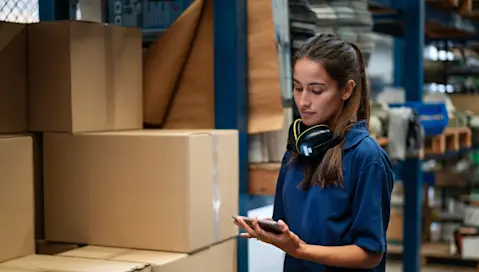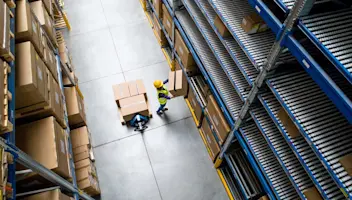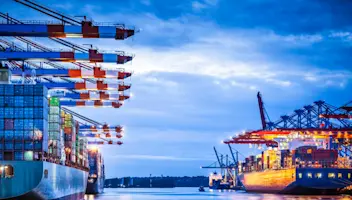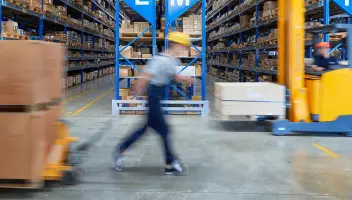Going Green with Sustainable Packaging and Supply Chain Management
Going Green with Sustainable Packaging and Supply Chain Management
Going Green with Sustainable Packaging and Supply Chain Management
16 Feb 2022
Ken Weygand
Sustainability must be an integral part of your business strategy moving forward. Not only is there increasing pressure from international organizations for companies to accelerate their sustainability efforts, but consumers also expect companies to demonstrate corporate responsibility. In fact, almost half of U.S. consumers stated that they would change purchasing habits to reduce their environmental impact, according to Nielsen.
For consumer goods distributors, the focus needs to be on the supply chain as the key component in reducing waste and maintaining sustainable business practices. Why? Because the supply chain accounts for more than 90% of most consumer goods companies’ environmental impact. In addition, these distributors must reduce greenhouse gas (GHG) emissions by more than 90% by 2050 in order to meet international climate change standards.
Considering that 80% of GHGs stem from supply chain operations, that’s a tall order. So how can consumer goods distributors accomplish it? By leveraging technology to gain greater visibility into the supply chain.
Read on to discover what your company can do to reduce your environmental impact through small changes to your supply chain—rather than trying to upend your entire business operations.
Rethink Your Packaging
In the push toward sustainability, one of the biggest change drivers is the packaging of consumer goods. According to McKinsey, the top 100 consumer goods companies have made serious, long-term commitments to drive sustainable packaging, with the biggest focus on using recycled packaging materials. The reduction of plastics and the innovation of new types of packaging, as well as the concept of returnable and reusable packaging, have spurred the industry to new innovations.
Environmentally friendly packaging options are more expensive right now, so you may want to raise prices slightly to offset this change. However, consumers worldwide have stated that they would be willing to pay more for sustainable products. In the U.S., over 42% of consumers said that they would pay for sustainable goods and services.
If you’re not sure about what options are available to you, a simple change to the size of your packaging can make a difference. Using smaller boxes, bags or containers for your products not only makes sense, but it can reduce your shipping costs, as well. If you don’t need filler materials, don’t use them. You can also ask your ocean freight providers to reduce dunnage on your international shipments. You can reduce costs by some 3% just by decreasing dunnage.
Perhaps you could think about recycling or reusing packaging. Some companies have opted to use reusable plastic totes or wheeled merchandise units, as opposed to “one-trip” transit packaging. For example, British-based home improvement company B&Q now uses reusable plastic packaging for delivery of their kitchen worktops. Previously, they had been packaged in cardboard which then got thrown away. In addition, the worktops often arrived damaged as the cardboard wasn’t sturdy enough to alleviate breakage during transit.
By making that simple switch, the company has eliminated thousands of pounds of cardboard waste and the damage rates have dropped from 6% to less than 1%. If you’re still worried about damage, but want to make a small commitment, ask your shipping company about using packaging materials made from recycled materials, such as corrugated cardboard “bubble wrap.” Air pillows are another sustainable packaging idea because they use minimal material and still keep products safe during shipping.
Biodegradable packaging materials are also a viable option. They are incredibly durable and are crafted entirely out of biological sources. For example, cornstarch packaging is strong like plastic but is made of organic materials. Mushroom packaging uses agricultural waste. It’s compostable, water-resistant, and shelf stable for up to 30 years. It also insulates from extreme temperatures, so will help prevent warping of goods that are susceptible to temperature changes.
There are plenty of ways to go green with your packaging. Just be sure that whatever you choose, your efforts are manageable long-term. Start off with small changes, measure the results, and then move on from there. You want to be ahead of the curve as environmental legislation becomes more restrictive, so the more changes you make now, the better positioned you’ll be in future.
Optimize Supply Chain Management
A well-run supply chain naturally reduces waste because it keeps supply aligned with demand, so it’s a vital part of your sustainability strategy. A sustainable supply chain is about more than the environment—it also affects efficiency and how your company is perceived. Sustainability means thinking about the long game and making business decisions in terms of human and environmental impact.
If sustainable business practices aren’t enough of an incentive for you, think about this. Robust supply chain management (SCM) software will also help you boost profits.
The global supply chain has been beleaguered with issues for more than a year, and supply and demand have been volatile. You might have known that SCM software gives you complete visibility into every step in your supply chain. But did you know that SCM can also help you embrace sustainable business practices?
The pandemic forced many distribution companies to scramble in the face of wild supply chain disruptions. In addition, consumers’ expectations for service and convenience have skyrocketed with the growth of online shopping.
An SCM is the key to digital transformation of the supply chain. Distributors can meet high customer expectations because full visibility allows your company to remain nimble and adapt to changes in product availability, international logistics and other variables. But there’s another benefit to SCM software—it promotes sustainability because it reduces wasted inventory and wasted space in the warehouse.
Distribution ERP with built-in SCM capabilities provides your entire team with visibility and control across the entire supply ecosystem, so you can make data-driven decisions based on real-time knowledge of manufacturing shutdowns, inventory shortages and overages, and even pricing changes. Add in an integrated EDI, and your documents will meet all regulatory and compliance requirements and be processed instantly with no paperwork. In short, SCM keeps the physical flow of goods integrated with the electronic flow of information.
Because of this, you will know down to the smallest SKU what inventory you have on hand. Through historical sales figures, you can accurately predict demand. This translates to less waste because you won’t have excess products sitting around in a warehouse, which in turn means lower shipping costs, lower production costs, and minimal carrying costs.
Since your supply chain is now optimized, your management team can focus on reducing waste in every aspect of the distribution process. ERP with built-in SCM tools enables distribution companies like yours to procure better goods and get them to customers faster and cheaper. An efficient and resilient supply chain will not only boost profits, but it can be the key to maintaining a sustainable organization—now, and in years to come.
Want to learn more about amplifying your sustainability efforts with technology? Talk with one of our distribution industry experts to find out how Aptean can be a game-changer for your distribution business.
Related Articles


Ready to start transforming your business?
We’ve got the specialised ERP solutions you need to conquer your industry challenges.






